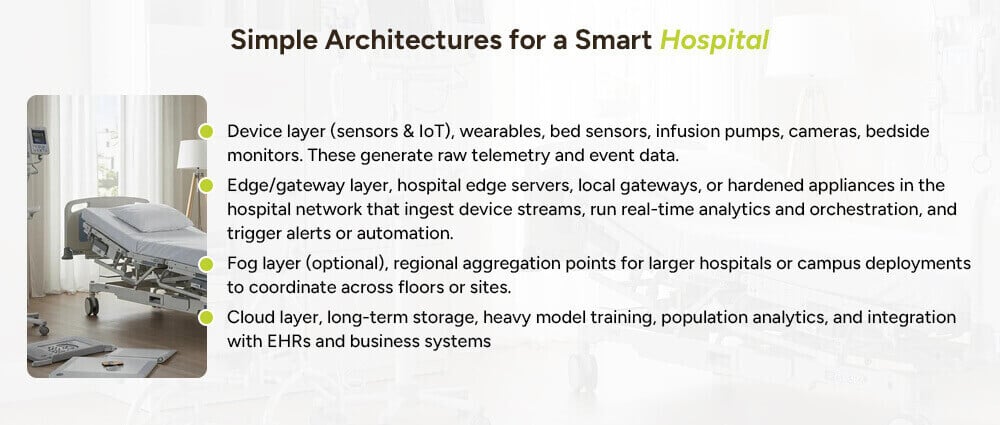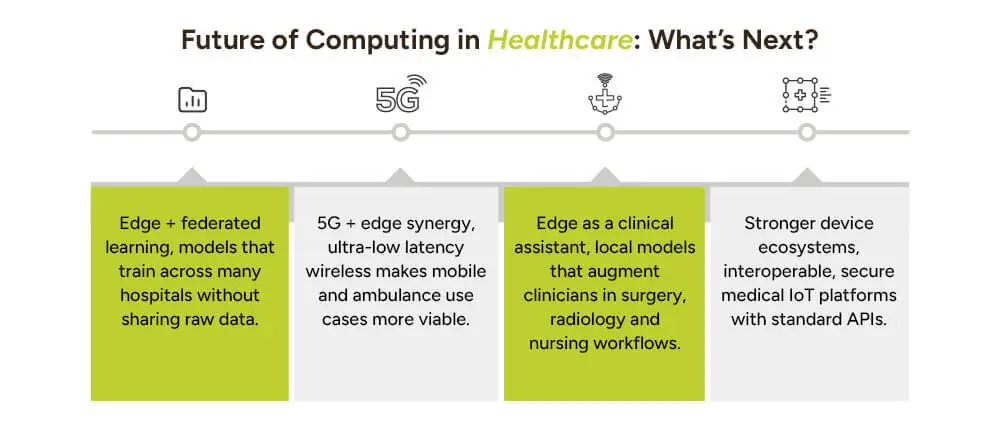Hospitals are no longer just buildings with beds and corridors; they’re becoming data centers on the move. Between bedside monitors, wearable sensors, smart IV pumps, imaging devices and building systems, modern hospitals produce massive amounts of data every second. To turn that stream into immediate, actionable care we need computing where the data is born, not 1,000 miles away in a cloud datacenter. That’s where edge computing in healthcare and IoT architectures for smart hospitals step in: processing, analyzing and acting on data at the bedside or inside the hospital network for true real-time healthcare.
Today, we’ll explain practical architectures, real edge computing applications in healthcare, high-impact use cases, measurable benefits, and best practices you can adopt today, all in plain language and with two solid industry stats to anchor the case.
Imagine a cardiac telemetry monitor that detects a dangerous arrhythmia. If that monitor must send raw waveform data to a distant cloud, wait for analysis, then return an alert, valuable seconds, or minutes, are lost. Edge nodes (local servers, gateways, or even smart devices) analyze the waveform immediately, surface the alert to clinicians, and optionally send a summarized record to the cloud for archival and analytics.
That drop in latency and the ability to filter and pre-process large data streams is why Edge Computing Transformation in Healthcare is more than a buzzword; it’s a practical shift that enables real-time decisions in critical care. Edge also reduces bandwidth and lowers the exposure of sensitive data in transit, improving privacy and compliance.
A reliable smart-hospital architecture usually layers computing so each task runs where it makes most sense:

This hybrid lets you run immediate detection and automation at the edge while keeping the cloud for heavy lifting, historical analytics and cross-site intelligence.
Edge computing in healthcare unlocks a range of practical, high-value applications:
These edge computing applications in healthcare reduce noise, surface the right events, and free clinicians to act faster with higher confidence.
Market growth: Analysts estimate the edge computing in healthcare market will grow substantially, from roughly USD 6.18 billion in 2024 to about USD 38.12 billion by 2032, driven by demand for low-latency processing and real-time care use cases. This creates strong commercial incentive to adopt edge architectures.
Performance impact: Research comparing edge-enabled clinical systems shows dramatic latency and network improvements, in one study, moving analytics to the edge produced an average latency reduction of about 87.7× and improved overall network efficiency (bandwidth) by roughly 2.6×, results that matter a lot in critical workflows.
Use cases like real-time arrhythmia detection or surgical-assistance AI become possible when inference runs locally with those kinds of performance gains.
When evaluating whether to adopt an edge + IoT model, hospitals repeatedly cite a set of powerful advantages that improve clinical outcomes, operational reliability, and cost efficiency. Let’s look at each benefit in detail.
In the healthcare field, every second matters and can be the difference between saving a life or not. By utilizing IoT and edge computing in healthcare, the data of patients coming from monitors, imaging devices, or wearables is being processed right where it’s collected instead of being sent to a faraway cloud for analysis. This has the effect of cutting down latency and thus, it is almost instant that doctors and nurses get notified, patients are updated, and diagnostic results are available.
To illustrate, when the oxygen saturation of a patient drops suddenly, the edge-based monitoring system will not just sit there and wait for cloud confirmation but will instead send an alert to the medical team right away. This rapidity allows for drug adjustments, interventions, and directed responses, especially in emergency rooms, ICUs, and operating theaters, among others, to be done faster and to save lives.
Every minute, hospitals are creating huge data volumes ranging from medical imaging to IoT sensors and smart devices. All these unprocessed data are transferred to the cloud may push the network capacity to its limits and cause an increase in operational costs.
On the other hand, with edge computing, only the summaries, insights, and flagged anomalies are being sent to the cloud for storage, while the raw data is being processed and filtered right where it is produced. This scenario lessens the strain on hospital networks, cuts down on the use of bandwidth, and gives the IT teams an opportunity to manage the data more efficiently. In other words, the edge allows hospitals to smartly deal with the “data noise”, that is keeping the useful part and throwing away the rest.
Every healthcare institution puts the safeguarding of patient information as their main priority. The adoption of edge computing in the healthcare sector elevates the level of data security because it enables the processing of sensitive patient data at the local hospital, or at least very close to the point of care.
This type of processing means that the personal health information (PHI) will not undergo long travels across the internet to the remote data centers, hence the risk of interception or breaches is significantly decreased. Furthermore, it makes it easier to adhere to the strict regional data protection regulations, such as HIPAA, GDPR, or any local health data law. By ensuring that the sensitive data remains within the controlled perimeter, hospitals obtain the dual benefit of enhanced privacy and seamless compliance.
Hospitals cannot afford downtime, even a short network interruption can disrupt care delivery. Edge computing in healthcare ensures continuous operation by processing data locally, independent of external internet connectivity.
So even if the hospital’s connection to the cloud is temporarily lost, critical systems, like patient monitors, medication pumps, or diagnostic devices, continue functioning seamlessly. This built-in resiliency guarantees uninterrupted service and patient safety, making edge computing a cornerstone of high-availability healthcare IT infrastructure.
Running every application and storing every piece of data in the cloud can become expensive over time, especially with continuous data streaming from thousands of devices. By adopting an edge architecture, hospitals reduce cloud egress, bandwidth, and storage costs, since most processing and filtering happen locally.
Moreover, edge computing allows for targeted investments, hospitals can deploy high-performance edge nodes only where they’re needed most (like ICUs or surgical departments) rather than scaling cloud capacity across all systems. The result? Lower operational costs, better resource allocation, and a strong long-term ROI for healthcare organizations.
Put simply, edge computing transforms constant device chatter into meaningful, actionable insights. Instead of drowning in unfiltered data, hospitals can focus on what truly matters, faster responses, better care, and smarter decisions. With the right strategy, edge + IoT technologies make healthcare not just more connected, but also more intelligent and human-centered.
If you’re designing Edge computing applications in healthcare or planning pilots, use these practical best practices:
These are the Best practices for edge computing in healthcare that teams with successful deployments follow.
The Future of Computing in Healthcare looks hybrid and distributed. Expect:

The future is less about cloud vs. edge and more about using each layer where it delivers the most clinical and operational value.
At Arpatech, we empower hospitals and healthcare providers to build intelligent, secure, and compliant edge-to-cloud ecosystems. Our team specializes in:
Whether you’re upgrading existing hospital systems or launching a smart healthcare initiative from the ground up, Arpatech Cloud provides the technical backbone and strategic expertise to make it happen faster, safer, and smarter.
Transform your healthcare infrastructure today.
Short answer: Cloud computing centralizes heavy processing, storage, and long-term analytics in remote datacenters; edge computing moves processing closer to the devices (bedside, gateway, or hospital server) so time-sensitive tasks run locally.
In practice: use the edge for real-time inference, immediate alarms, privacy-sensitive preprocessing, and to keep services running during network outages. Use the cloud for migration, training models, population-level analytics, archival storage, and cross-facility reporting. A hybrid approach, edge for speed and privacy, cloud for scale and longitudinal intelligence, is the recommended pattern for modern smart hospitals.